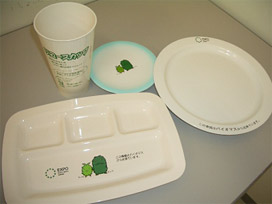Biodegradable plastic eating utensils
- At food and beverage facilities -
One of the pleasures to be enjoyed by visitors to EXPO 2005 Aichi, Japan will be the gourmet food. Here’s an introduction to environmental preservation measures relating to gourmet food.
At the Exhibition site, the many food and beverage facilities will range from restaurants to fast food outlets. The amount of eating utensils used at all these facilities will be enormous; if conventional fossil-fuel-derived plastics were used for these utensils, they would be disposed of by landfill or incineration, which is never good for the global environment.
EXPO 2005 Aichi, Japan will employ biodegradable plastics for the more than 10 million eating utensils to be used at the food and beverage facilities. This will be the first time biodegradable plastics have been used for such an enormous number of eating utensils, in a single project.
The one-way (disposable) plates, spoons, forks and straws, mainly used at food courts, will be collected together with garbage including leftovers and transported to professional disposal companies, who will make compost from the utensil waste and garbage at facilities outside the site.
On the other hand the returnable eating utensils, of greater strength (for repeated reuse) will be mainly used at restaurants. At then end of their service life, these utensils will be collected for recycling.

Returnable utensils to be used at restaurants
Biodegradable plastics
Conventionally, it is taken for granted that plastics are made of fossil fuel. These conventional types of plastics are widely used everywhere in the world, since they excel in strength and durability, and can be produced in mass numbers, even at a low cost. As regards disposal, however, these plastics pose difficult environmental problems. If disposed of by landfill, the plastics worsen the shortage of landfill sites. If the plastics are incinerated, they emit poisonous gases such as dioxins, which are among the great environmental problems. The disposal of plastics thus remains a thorny global environmental issue.
On the other hand, the “biodegradable plastics” introduced here are very friendly to the environment. Produced from the starch of corn and the like, these plastics have functions similar to conventional plastics; being biodegradable, however, when disposed of they are decomposed by microbial action into water and carbon dioxide (CO2). Some people might think that if this decomposition process involves the release of CO2, it could affect global warming. However, unlike CO2 emissions from incinerated fossil fuel products (i.e., total quantity of CO2 increases), in the above process CO2 that has already been absorbed by the corn through photosynthesis will merely be returned to the atmosphere (i.e., total quantity of CO2 does not increase). It can therefore be said that biodegradable plastic disposal makes use of the natural CO2 cycle.
However, biodegradable plastics have the following disadvantages compared with the conventional plastics.
- Less heat-resistant
- Inferior in molding precision (cannot be used for precision components)
- More expensive
Currently, biodegradable plastics are in demand for disposable or near-disposable products, such as plastic bags, toothbrushes and eating utensils, which do not require high dimensional accuracy. However, technological development has progressed in recent years, to the extent that the application of biodegradable plastics to audiovisual equipment, compact discs and automobile components is much talked about.
At a Cabinet meeting in December 2002, the Japanese government also adopted the “Biomass Nippon Strategy” to promote biomass use as a nationwide effort. The Strategy stated that “we will be actively involved in the introduction of biodegradable plastic products at the EXPO (2005 Aichi) event.”
Compost
Compost is a product resulting from the biological decomposition of organic waste, such as sludge and garbage. Compost can be made by adding microorganisms to organic waste materials, which then ferment by microbial action. Since biodegradable plastic products are decomposed by microbes into water and carbon dioxide, they can be composted along with garbage.
There are various forms of composting equipment, from large-scale composting plants, operated by local governments and private businesses, to small compost processors for household use.


